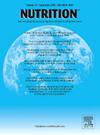Association between muscle mass assessed by an artificial intelligence–based ultrasound imaging system and quality of life in patients with cancer-related malnutrition
IF 3.2
3区 医学
Q2 NUTRITION & DIETETICS
引用次数: 0
Abstract
Introduction
Emerging evidence suggests that diminished skeletal muscle mass is associated with lower health-related quality of life (HRQOL) in individuals with cancer. There are no studies that we know of in the literature that use ultrasound system to evaluate muscle mass and its relationship with HRQOL.
Objective
The aim of our study was to evaluate the relationship between HRQOL determined by the EuroQol-5D tool and muscle mass determined by an artificial intelligence–based ultrasound system at the rectus femoris (RF) level in outpatients with cancer.
Material and methods
Anthropometric data by bioimpedance (BIA), muscle mass by ultrasound by an artificial intelligence–based at the RF level, biochemistry determination, dynamometry and HRQOL were measured.
Results
A total of 158 patients with cancer were included with a mean age of 70.6 ±9.8 years. The mean body mass index was 24.4 ± 4.1 kg/m2 with a mean body weight of 63.9 ± 11.7 kg (38% females and 62% males). A total of 57 patients had a severe degree of malnutrition (36.1%). The distribution of the location of the tumors was 66 colon-rectum cancer (41.7%), 56 esophageal-stomach cancer (35.4%), 16 pancreatic cancer (10.1%), and 20.2% other locations. A positive correlation cross-sectional area (CSA), muscle thickness (MT), pennation angle, (BIA) parameters, and muscle strength was detected. Patients in the groups below the median for the visual scale and the EuroQol-5D index had lower CSA and MT, BIA, and muscle strength values. CSA (beta 4.25, 95% CI 2.03–6.47) remained in the multivariate model as dependent variable (visual scale) and muscle strength (beta 0.008, 95% CI 0.003–0.14) with EuroQol-5D index. Muscle strength and pennation angle by US were associated with better score in dimensions of mobility, self-care, and daily activities.
Conclusion
CSA, MT, and pennation angle of RF determined by an artificial intelligence–based muscle ultrasound system in outpatients with cancer were related to HRQOL determined by EuroQol-5D.
基于人工智能的超声成像系统评估的肌肉质量与癌症相关营养不良患者生活质量之间的关系
导言:越来越多的证据表明,骨骼肌质量的减少与癌症患者健康相关生活质量(HRQOL)的降低有关。我们的研究旨在评估门诊癌症患者中由 EuroQol-5D 工具测定的 HRQOL 与由基于人工智能的超声系统测定的股直肌 (RF) 肌肉质量之间的关系。材料和方法通过生物阻抗(BIA)测量人体测量学数据、通过人工智能超声系统测量股直肌水平的肌肉质量、生化测定、测力法和 HRQOL。平均体重指数为 24.4 ± 4.1 kg/m2,平均体重为 63.9 ± 11.7 kg(女性占 38%,男性占 62%)。共有 57 名患者存在严重营养不良(36.1%)。肿瘤位置分布为:结肠直肠癌 66 例(41.7%)、食管胃癌 56 例(35.4%)、胰腺癌 16 例(10.1%)、其他位置 20.2%。横截面积(CSA)、肌肉厚度(MT)、五点角、(BIA)参数和肌肉力量呈正相关。低于视觉量表和 EuroQol-5D 指数中位数的组别中,患者的 CSA、MT、BIA 和肌力值较低。在多变量模型中,CSA(贝塔值为 4.25,95% CI 为 2.03-6.47)仍是因变量(视觉量表),肌力(贝塔值为 0.008,95% CI 为 0.003-0.14)与 EuroQol-5D 指数相关。结论基于人工智能的肌肉超声系统在门诊癌症患者中测定的射频肌肉强度(CSA)、肌张力(MT)和五连角(Pennation angle)与 EuroQol-5D 测定的 HRQOL 有关。
本文章由计算机程序翻译,如有差异,请以英文原文为准。
求助全文
约1分钟内获得全文
求助全文
来源期刊

Nutrition
医学-营养学
CiteScore
7.80
自引率
2.30%
发文量
300
审稿时长
60 days
期刊介绍:
Nutrition has an open access mirror journal Nutrition: X, sharing the same aims and scope, editorial team, submission system and rigorous peer review.
Founded by Michael M. Meguid in the early 1980''s, Nutrition presents advances in nutrition research and science, informs its readers on new and advancing technologies and data in clinical nutrition practice, encourages the application of outcomes research and meta-analyses to problems in patient-related nutrition; and seeks to help clarify and set the research, policy and practice agenda for nutrition science to enhance human well-being in the years ahead.
 求助内容:
求助内容: 应助结果提醒方式:
应助结果提醒方式:


